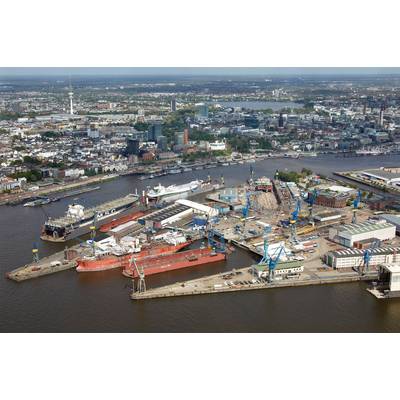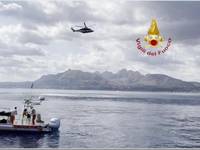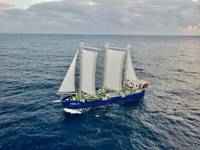Insights with an Kees Pilaar MD, Blohm + Voss
It could be argued that running an efficient, safe and profitable ship repair yard is one of the most difficult of all maritime jobs. First and foremost, unpredictability – in terms of planned and actual workload, as well as the very nature of the job themselves – is a recurring theme. Maintaining experienced staff in times good and bad; keeping ahead of evolving regulations, as they pertain to the local environment and the global ship market; and weathering the inevitable influx of cut-rate competition from emerging nations are but a sampling of the issues ship repair managers face every day. To get answers to some tough questions, Maritime Reporter recently spent some time with Jan Kees Pilaar, managing director of one of the world’s long-tenured and storied shipyards, Hamburg, Germany based Blohm + Voss.
Please provide a brief background on how you come to your current position.
Pilaar In 1992 Keppel Verolme Shipyard appointed me as their Senior Business Manager for the yard’s offshore repair and maintenance activities. In 2005, when the shipyard group ThyssenKrupp Marine Systems, a result of the merger of the HDW-Group and ThyssenKrupp Werften, was established I was appointed by ThyssenKrupp to become Managing Director for the repair activities of Hellenic Shipyards in Greece. On the decision by ThyssenKrupp to sell Hellenic Shipyards in 2008/2009, ThyssenKrupp Marine Systems offered me the position as Managing Director at Blohm + Voss Repair in Hamburg.
As of May 1, 2009 I accepted this position and managed beside my daily business, the selling process of Blohm + Voss Repair, as part of the civil shipbuilding activities of Blohm + Voss, to the final closing with Star Capital Partners. Since the closing has taken place on January 31, 2012 I operate as Managing Partner at Blohm + Voss Repair.
Give us the Executive Overview of Blohm + Voss’ ship repair capabilities today?
Pilaar Blohm + Voss Repair in Hamburg is the premier address for ship owners and managers requiring a specialized shipyard for conversions, refits, repairs and routine drydockings focusing on passenger/cruise vessel and offshore units for the oil and gas industry. We repair anything that floats, is our slogan! Shipyard work on a passenger/cruise vessel is one of the industry’s ultimate challenges; assignments include work on the hull, hotel and public areas, machinery and operating systems. Blohm + Voss Repair has the facilities and expertise as well as a first class reputation for punctual deliveries of such tasks – its management and motivated labor pool make the impossible possible. Its work force is both experienced and flexible, and can be increased in numbers as well as trades at very short notice due to Hamburg’s centre pin location and far-flung infrastructure.
Blohm + Voss Repair in Hamburg on the River Elbe is easily accessed by equipment operated by the Northern Atlantic and North Sea offshore industry. Blohm + Voss Repair staff is renown for fast conversions and 7/24 repairs always working on-time and to budget. Specialist expertise includes conversions and modifications, lengthening, re-engining, refits, upgrades, lifetime extensions and repairs to offshore units, rigs, tankers, LNG/LPG gas tankers, FPSO’s as well as work on wind power and oil industry support vessels.
What do you count as the primary strength of your company?
Pilaar We have very sophisticated project management. In combination with the long lasting experience of more than 135 years in ship building at Blohm + Voss at a glance, this will come to a very good customer focus to understand the needs and requirements in handling complex projects in the field of passenger/cruise vessels as well as in proceeding projects for the oil and gas industry.
In what areas do you see room for improvement?
Pilaar In general, Blohm + Voss Repair is very well positioned in the market. The most challenging task is to get the “old lady” Blohm + Voss Repair attractive to the market participants. We have to work against the impression, that we are an “old” and “traditional” company. During the years, we always adapt ourselves to the requirements of the market in the field of service, management systems and customer orientation. To get this spirit alive is a task that has to be proved on daily basis. “Is not possible, does not exist!”
There are some tough economic and budgetary times: How has the recent economic slump affected your business?
Pilaar Less projects and orders in the general ship repair business are leading to more competition in the market. And at the very end, the price is the essential point whether you will get an order or not!
In your opinion how are ship owners today most the same, and most different in their approach to procurement of ship repair and conversion?
Pilaar Also for shipowners nowadays it is difficult to earn a dime. Export market in Europe is basically low and a heavy influence of the financial crisis is present. So, if not much is earned, not much can be spent. And we notice this. I believe however in quality and we deliver quality. I hear this again and again from our customers. And this we have to maintain, the goal for us is to offer the quality against competitive prices. So nowadays we do a lot with regular returning customers who value this.
What do you consider the biggest challenge in running your business today?
Pilaar From my point of view, effective project controlling is most essential to run a modern and efficient repair and conversion yard these days. You must be informed how a project/order will run, actually on a daily basis. Whether you will run out of budget or you will be in budget. And this is not only for your own financial security but also as a service to your customer, since he also wants to compare against to the budget he has available.
In the face of cheaper ship repair alternatives in the Far East, what do you count as the biggest challenge to run a German-based ship repair business today?
Pilaar Stay and be focused! Select a project, evaluate if this is good project for the yard. And then work on the project until the order is there. You can only succeed if you know what you want and what route you take to get there. We know very well when we have to do a “technical sale” or a “price sale.” If we can beat the competition on our technical skills and competence we will give such a project priority.
Over your career, what do you consider to be the leading technologies or developments that have positively impacted the business of repairing ships?
Pilaar The change of mindset to what is today called “Green Shipping.” In conjunction with it, the development of new technologies and techniques to keep the environment cleaner. This applies not only for ships in operation but also for the treatment of ships being at the yard. For example the treatment of ship hulls from grit blasting to hydro blasting was generated by Blohm + Voss Repair. Together with our wastewater treatment plant, where we collect the waste water from our docks, we have made a big step even to a “green shipyard” and prove that German shipyards are advanced in regard to sophisticated technologies.
How is Blohm + Voss investing today?
Pilaar First of all, we invest in our staff. It is important, even for a German-based repair yard, that our employees will always be trained on the highest business and technical standards. Further on, we invest in our operational resources because a repair yard can not work if their equipment is not accurately maintained and on the current technical standard. Our new owner Star Capital believes in this view as well. Combine tradition with nowadays knowledge and you are top of the Bill!
What do you count as the most interesting or challenging ship repair job you and your company has ever been involved?
Pilaar The two most interesting and challenging repair jobs in the last years were the conversion of KRAKA to DAN SWIFT for Lauritzen Tankers and the lengthening of the cruise vessels BALMORALl and BRAEMAR for Fred. Olsen Cruise Lines.
When the KRAKA docked late 2007 at Blohm + Voss Repair, a long, demanding conversion program awaited the vessel, turning it from an uncompleted cable layerinto an ocean going, dynamically positioned accommodation and support vessel.
Shipbuilding work included the addition of over 1,600 tons of steel, pulling of 400 km cables and the instalment of 40 km of new piping.
Accommodations for 291 were created along with all facilities such as galleys, provision rooms, messes, laundries, recreation, cinema and fitness rooms as well as a swimming pool. New ship operations kit included a new bridge, engine control centers, workshops, a HVAC plant, and fire fighting, sprinkler, CO2 and water mist systems. Amongst further sophisticated equipment, the vessel received three new azimuth thrusters, offshore gangways, a helicopter deck, dynamic positioning, integrated navigation, thruster control and power management systems. After completing the staggering program, the vessel, now renamed DAN SWIFT by its owner J. Lauritzen, left Europe to commence a new life working adjacent to fixed structures, platforms and floating units in Brazil’s new offshore oil and gas fields, where she supplies accommodation, hook-up, ommissioning, start-up, maintenance, light construction and crane support.
In November 2007 the cruise ship BALMORAL (ex Norwegian Crown) was docked at Blohm + Voss Repair to be lengthened by a new mid-body section of 30.2 meters.
In January 2008 the completed cruise ship left Blohm + Voss, now with increased length and passenger capacity heading to Southampton where the cruise ship was handed over to her owner. In May 2008 the BRAEMAR (ex Crown Dynasty) was docked the get the same treatment as BALMORAL. The cruise ship was cut in two pieces in order to be lengthened also by a new mid-body section on 31.2 meters. Besides this, 18 balconies were installed and the restaurant on Deck 8 was completely renovated. What was proved with BALMORAL fits also the BRAEMAR and the cruise ship with an increased capacity of 988 passengers left Blohm + Voss Repair on July 2, 2008, within time and within budget again exactly what our clients expect from us what we deliver.
(As published in the August 2012 edition of Maritime Reporter - www.marinelink.com)









